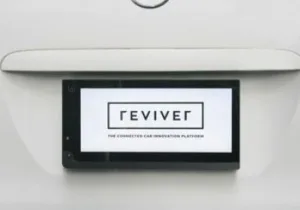Advertised as the first-ever, interactive digital license plate, the so-called rPlate debuted earlier this year at the North American International Auto Show. This show is held in Detroit as a part of Automobili-D. The event is new and showcases connected car technology. The company claims that this Internet of Things device will “open the door to radical change in the most dated part of your vehicle, that stamped piece of aluminum that dates back to 1903.”

The rPlate, developed by Reviver (Foster City, California), can be installed as an aftermarket product or integrated into the design of new vehicles.
The Reviver license plate is illustrated in the figure below.
 The Reviver electronic license plate.
The Reviver electronic license plate.
A video at the end of this article illustrates and discusses the Reviver electronic license plate.
The Reviver license plate consists of a 6″ x 12″ (15cm x 30cm) monochrome, bistable display reportedly sourced from Advantech. These dimensions are the same as typical U.S. license plates. The device contains the capability for wireless connectivity, a battery, a processor, a GPS, an accelerometer, RF sensors, storage and CAN bus access. (CAN bus or “Controller Area Network is a robust vehicle bus standard designed to allow microcontrollers and devices to communicate with each other in applications without a host computer.”) The license plate has an anti-reflective cover sheet. The company claims that the device is legible in and built to withstand all weather conditions.
The Reviver system is set up such that it is the company’s control center that manages the specific information presented on any individual license plate. None-the-less, it is the registration authority, the DMV, state legislatures, troopers or highway patrol that collectively have the final say as to what can and cannot be displayed on the license plate.
Consistent with these constraints, potential uses for the device suggested by the company include the following:
- Instantly updated registration status. This capability would eliminate the need for stickers and the need for the vehicle owner to visit a motor vehicle office*.
- This capability could also enable pay-by-the-month registration options.
- Could enable convenient flexibility between types of license plates. As an example, rPlate could allow the vehicle owner to choose characters or graphics that show support for a cause or enable a “vanity” license plate.
- Presentation of parking status that could dovetail with smart parking apps and/or services.
- Display emergency broadcasts such as extreme weather warnings, amber alerts and other public service messages.
- Reduce theft and fraud. The license plate could become nonfunctional if it is stolen from the car for which its’ use is intended.
- Provide fleet management and telematics capabilities. (Telematics is “the branch of information technology that deals with the long-distance transmission of computerized information.”)
- Advertising of various kinds. More specifically, when a vehicle is legally parked in any location, the plate could display hyper-local targeted messages. Note that, even when the car is parked and presenting messages, the license plate number would always be visible somewhere on the display screen.
- VIN-specific recall notifications.
- Automate the payment of toll road charges and parking fees.
Reviver is still sorting out some issues related to the use of the electronic license plate.
- How much the license plate will cost and who pays that cost.
- How the license plates can be sold beyond the fleet market. One thought is that luxury car dealers could offer the device as a premium option.
- What limits each state may place on extraneous messaging that can be displayed on the license plate.
Prototype rPlates are already operational in California. The company says that, during 2018, up to 100,000 cars will be deployed in California. Initially, most of these will be fleet and commercial vehicles. The device has also been approved for use in Florida and preliminary approval has been achieved in Arizona. Reviver is also attempting to obtain approval this year in Texas. Beyond these states, the company is looking at Michigan, Oregon, Virginia, New Jersey, Nevada and Utah as potential markets for the product.
At Automobili-D, Reviver also “unveiled the rStore, a cloud-based app development platform that will host apps designed to maximize the functionality of fully connected vehicles. The rStore will offer an open platform for 3rd party development of apps.”
During January of this year, Reviver raised $6.8 million during a Series A round of funding co-led by WRV and Australian-based ACK Group. The investment is intended to help fund the expansion of the company’s engineering team so as to accelerate the development of the next generation rPlate. Reviver also intends to use funds to further expand distribution of the rPlate into other U.S. states and to explore international opportunities – Arthur Berman
Reviver, Neville Boston, 949-903-3777
* In the UK, the use of stickers to show payment of vehicle tax has already been abandoned as IT, including number plate recognition, is now such that the stickers are no longer needed. (BR)

